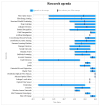Machine Learning Applications in Optical Fiber Sensing: A Research Agenda
- PMID: 38610411
- PMCID: PMC11014317
- DOI: 10.3390/s24072200
Machine Learning Applications in Optical Fiber Sensing: A Research Agenda
Abstract
The constant monitoring and control of various health, infrastructure, and natural factors have led to the design and development of technological devices in a wide range of fields. This has resulted in the creation of different types of sensors that can be used to monitor and control different environments, such as fire, water, temperature, and movement, among others. These sensors detect anomalies in the input data to the system, allowing alerts to be generated for early risk detection. The advancement of artificial intelligence has led to improved sensor systems and networks, resulting in devices with better performance and more precise results by incorporating various features. The aim of this work is to conduct a bibliometric analysis using the PRISMA 2020 set to identify research trends in the development of machine learning applications in fiber optic sensors. This methodology facilitates the analysis of a dataset comprised of documents obtained from Scopus and Web of Science databases. It enables the evaluation of both the quantity and quality of publications in the study area based on specific criteria, such as trends, key concepts, and advances in concepts over time. The study found that deep learning techniques and fiber Bragg gratings have been extensively researched in infrastructure, with a focus on using fiber optic sensors for structural health monitoring in future research. One of the main limitations is the lack of research on the use of novel materials, such as graphite, for designing fiber optic sensors. One of the main limitations is the lack of research on the use of novel materials, such as graphite, for designing fiber optic sensors. This presents an opportunity for future studies.
Keywords: PRISMA; deep learning; fiber Bragg grating; fiber sensors; machine learning.
Conflict of interest statement
The authors declare no conflicts of interest.
Figures









Similar articles
-
Hybrid Fiber Optic Sensor Systems in Structural Health Monitoring in Aircraft Structures.Materials (Basel). 2020 May 13;13(10):2249. doi: 10.3390/ma13102249. Materials (Basel). 2020. PMID: 32414212 Free PMC article. Review.
-
Review of Chirped Fiber Bragg Grating (CFBG) Fiber-Optic Sensors and Their Applications.Sensors (Basel). 2018 Jul 4;18(7):2147. doi: 10.3390/s18072147. Sensors (Basel). 2018. PMID: 29973516 Free PMC article. Review.
-
Feasibility of fiber Bragg grating and long-period fiber grating sensors under different environmental conditions.Sensors (Basel). 2010;10(11):10105-27. doi: 10.3390/s101110105. Epub 2010 Nov 10. Sensors (Basel). 2010. PMID: 22163460 Free PMC article.
-
Fiber Optic Sensors Embedded in Textile-Reinforced Concrete for Smart Structural Health Monitoring: A Review.Sensors (Basel). 2021 Jul 21;21(15):4948. doi: 10.3390/s21154948. Sensors (Basel). 2021. PMID: 34372185 Free PMC article. Review.
-
Smart Polymer Composite Deck Monitoring Using Distributed High Definition and Bragg Grating Fiber Optic Sensing.Sensors (Basel). 2022 May 27;22(11):4089. doi: 10.3390/s22114089. Sensors (Basel). 2022. PMID: 35684713 Free PMC article.
References
-
- Leal-Junior A.G., Frizera A., Marques C., Pontes M.J. Optical Fiber Specklegram Sensors for Mechanical Measurements: A Review. IEEE Sens. J. 2020;20:569–576. doi: 10.1109/JSEN.2019.2944906. - DOI
-
- Bellavia D., Iacovoni A., Agnese V., Falletta C., Coronnello C., Pasta S., Novo G., di Gesaro G., Senni M., Maalouf J., et al. Usefulness of regional right ventricular and right atrial strain for prediction of early and late right ventricular failure following a left ventricular assist device implant: A machine learning approach. Int. J. Artif. Organs. 2020;43:297–314. doi: 10.1177/0391398819884941. - DOI - PubMed
-
- Liu G., Meng H., Qu G., Wang L., Ren L., Lu H. Real-time monitoring and prediction method of commercial building fire temperature field based on distributed optical fiber sensor temperature measurement system. J. Build. Eng. 2023;70:106403. doi: 10.1016/j.jobe.2023.106403. - DOI
-
- Xu W. Optical sensor based quantum computing in sports medicine for diagnosis and data analysis using machine learning model. Opt. Quantum Electron. 2024;56:528. doi: 10.1007/s11082-023-06066-z. - DOI
Publication types
LinkOut - more resources
Full Text Sources

